|
We left the house at 5:40 for a 6:00 soccer game. She was supposed to be there early to warm up. Took ten minutes to get there, except thanks to unexpected construction you cannot get there as easily as one might expect. We prowled around the park and the lake and I saw no soccer fields. Parked. Checked google; there was a school with the same name as the field in the vicinity, and it had soccer fields.
En route the phone rings, and it’s my wife, to remind us to go to soccer. Well, yes, that’s where we’re headed. It wasn’t at the park, it’s at the school.
No, my wife said, it’s 7:10, not 6:00.
Ah. Well. In the future, shoot me the emails you get about this, or put it on the calendar.
Mind you, I’d been driving around detours and back alleys and strange streets for 15 minutes; this part of Minneapolis I rarely visit, and it’s like a parallel world of my own part of town. Same layout, same bisecting parkway, lakes, and all the other delights of the city, but completely different. Daughter wanted to eat, since obviously we weren’t going to have 7:30 supper as planned. The only option was a McDonald’s.
“It has one star,” she said, looking at my phone.
“Why?”
“Augh! No I don’t want the Yelp app.” She had attempted to find out why this McDonald’s was so poorly rated, and had been pitched into the App Store. Which is just what you want. Oh that’s precisely what you want. Let me download an application so I can find out why someone was dissatisfied at a McDonald’s.
She read the first few lines of the review on the Google search page, and said that the orders were consistently short of items.
“It’s from 2012,” she said.
“They’ve probably fired the people or they stopped showing up or they learned to be more careful,” I said. “It probably just happened and someone was irritated.”
“It says it happened lots of times.”
“Well, then the person shouldn’t have been surprised, if that’s what happens there.
“It has a Play place!”
“Whoo-hoo!”
This is such a Minneapolis sight:
The old grain elevators. Hiawatha cuts diagonally through town against the grid, because it followed the rail lines, which came before the grid.
We went to the drive-through. “Anything else?” said the disembodied voice behind the metal speaker.
“Milk,” daughter said.
“Milk,” I said. “Skim.”
“Would you like to add anything else to your order?”
“No.” We drove through, paid, and advanced to the next window. A bag was handed out of the side of the building containing foodstuffs; the person who was doing the handing was talking to a co-worker. I asked for some condiments in the most efficient style possible: name of condiment, followed by quantity. Ketchups, four; pepper, two; salt, one; mustard, one.
“What?”
Because no one hears a thing you say until you say it again. Repeated the instructions. Two ketchup, no mustard, no salt.
Kindly pressed the matter until I was properly peppered. We pulled into the “eat in your car because life has come to this” slot and set about eating what was, technically, food.
“There’s no milk,” daughter said. “They forgot the milk.”
Should have got the Yelp app, I thought.
We went back for the milk and drove to the school. There was no soccer game going on. Called my wife for the directions from the email; she found it. I was supposed to go to the lake. When I’d said “It wasn’t at the park, it’s at the school” and she said “no,” this was in reference to my assertion that it was at the school, not the time.
Now, having been 40 minutes early, we were suddenly five minutes late. I drove east into the most eye-bleedingly bright sunset in the history of solar activity; it was literally blinding. I could not see anything. Stop signs. Pedestrians. Almost had daughter hang her head out the window and warn me about oncoming hazards, but when I leaned out I couldn’t see anything, either.
But. Found it. Dropped her off. Drove home.
They tied.

The weekly look at the way things used to be, and the expectations they had about the consumer.
For example: consumers would be attracted to clowns, and were insecure enough to be lectured about their taste in ceramics by a gum company. We begin, as always, with:
THE WEEKLY BORDEN
Elmer’s perpetual bad mood spins into contempt and abuse, two things generally regarded as fatal to any marriage. He’s obviously followed her downtown, and caught her coming out of a store with a new hat.
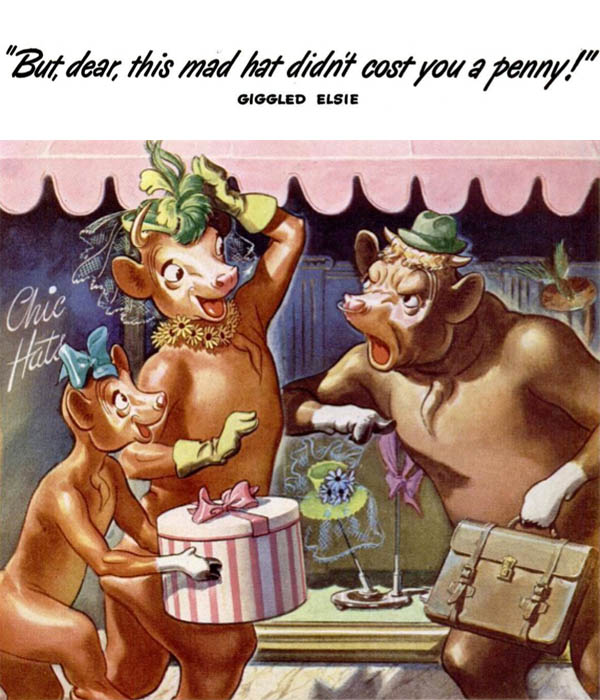
If a cow with a hat seems odd, remember, we are in a world where naked upright cows and bulls mingle with humans, and are even employed in office positions that require a briefcase. You can only imagine Elmer sprawled in his chair at work, snorting, the family jewels on complete display.
Anyway, Elsie giggles her response, because she finds his futile, impotent rage absolutely hilarious. She brings in all the money in the household, I’m sure, thanks to her lucrative Borden work. Elmer never accepted that, but it doesn’t matter.
Elmer goes on, and makes an odd remark: what did you spend instead of money, pins? But of course pin money is a term for money wives keep on hand for this and that. Note his conclusion:
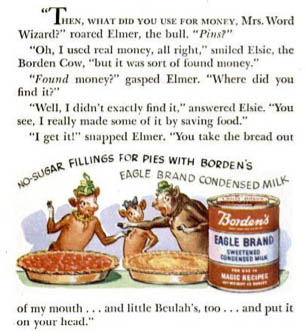
He accuses her of putting her hat needs above the nutritional needs of her child, as if that’s something she would do - and as if he doesn’t know that eventually this will all come around to Borden, and he will be shown to be wrong, again.
I think she handles him well enough.
STOREFRONTS
They used to show stores in these ads, telling you what type of chain facade you should look for. The first is a Hoover ad, but it’s not a Hoover showroom. It’s . . .
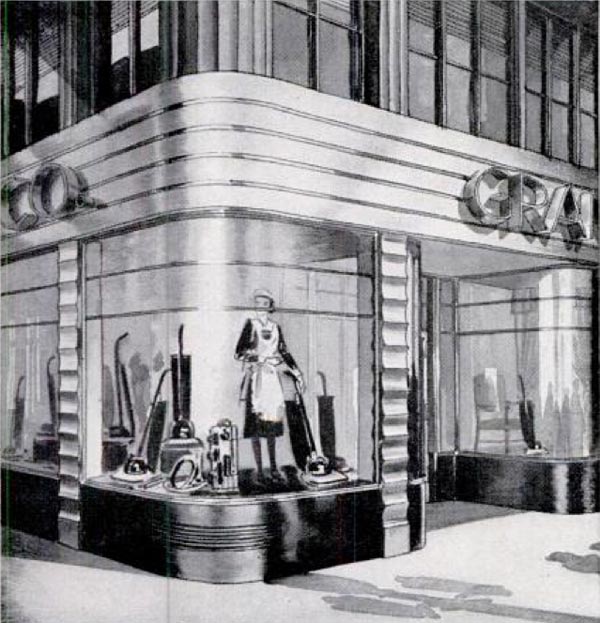
GRANCO? GRARCO? GRANT CO.? The latter might be the W.T. Grant company, which was a medium-tier 5 & 10 that had a run from 1906 to 1976. From wikipedia:
Grant's stores were slower than the Kresge stores to adapt to the growth of the suburb and the change in shopping habits that this entailed. The attempt to correct this was belated; in the 1960s and early 1970s, the company built many larger stores (later known as Grant City), but unlike Kresge's Kmart they lacked uniform size and layout, so that a shopper in one did not immediately feel "at home" in another.
This presumes that people went to different ones, which seems unlikely; how many would a town have? Target has different layouts, and while I know what it means not to feel “at home” in a strange target, it doesn’t keep me from going to the Target where I do feel at home.
The company made some boneheaded moves, borrowing money to pay shareholder dividends, and adopted a novel policy that’s now the norm:
A final tactic to stay in business involved requiring Grant's clerks and cashiers to offer a Grant's credit card application to customers to boost sales in the stores.
That sounded familiar; at some point I researched the chain, I guess, because I remember that they gave them to anyone, and lost huge amounts of money.
In any case, that's a beautiful storefront. Nothing ever looks so modern anymore; perhaps I'm just jaded.
Another bygone store:
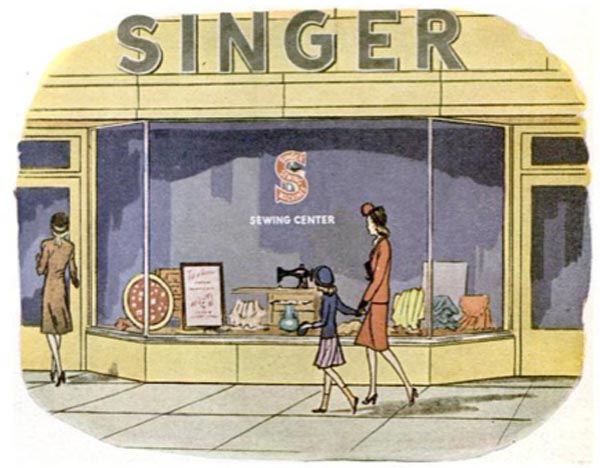
In the great era of conglomerates they owned a nuclear-power control manufacturer, a flight simulator manufacturer, Packard-Bell, and who knows what else. Now they’re back to sewing machines. Architecture fans recall them for the corporate HQ, one of the most graceful buildings of the early skyscraper era. It was the tallest building in the world, for a while - and the tallest ever to be demolished. (On purpose.)
Finally, an ad with a one-of-a-kind store:
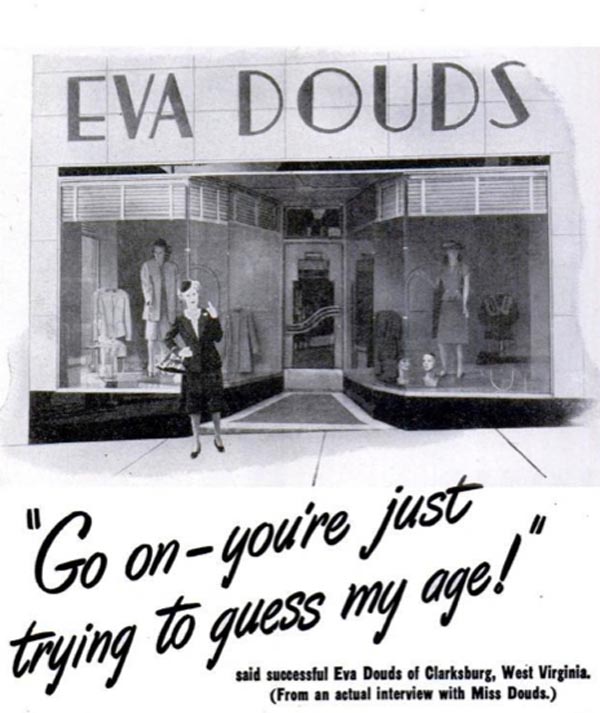
Those were standard for downtowns - the big plate-glass windows, the door with the stylish handle, porcelain sheets over the old brick.
Looking around the downtown now is just damned depressing; it appears gutted. Can’t find the store - street view doesn’t go everywhere, but I’d bet it’s gone. Streetview doesn’t show the cross streets, but I don’t think they have the uneven base you see above; that reflects the grade of the street. I’ve been up and down it on streetview, and there doesn’t seem to be any trace.
Possibly this.
A look around the downtown - which seems much bigger than the population of 16K warrants - shows some sad old storefronts whose status indicates that times have been lean for a very long time. A fifties job:
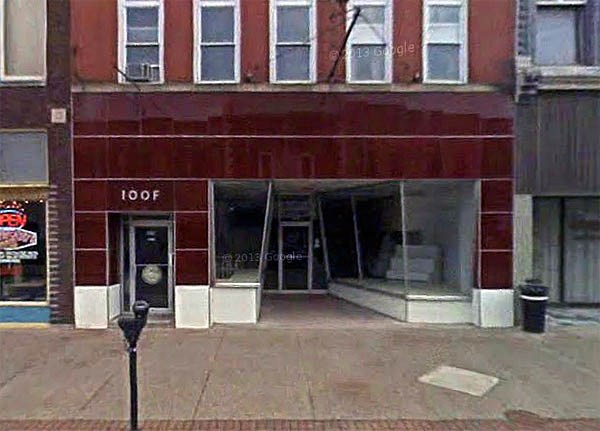
IOOF! The Walter Monheit social order. No, that would be the International Order of Fraternals. No, Independant Order of Odd Fellows.
This just makes you weep.
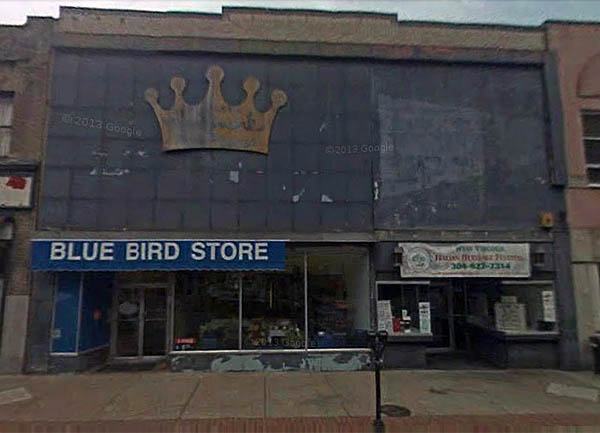
PLANTERS
A bit of peanuts to conclude: here's the whole ad. A lovely thing, drawn by hand. Let's all have a Fall Fiesta!
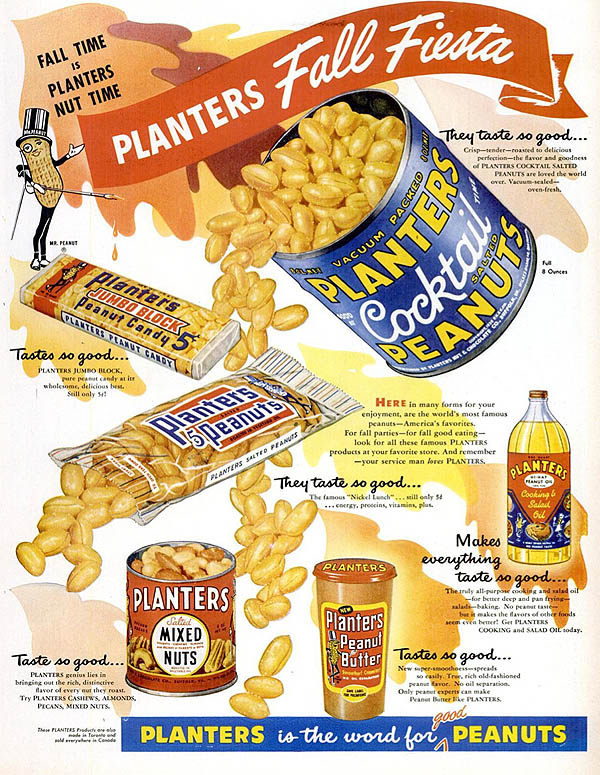
Makes you wonder if it's almost time for Fall Happiness Season, doesn't it? But more on that later.
New Comics, and the usual things in the usual places, which of course you've bookmarked, right? Of course!
|

